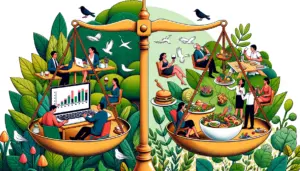Every problem has a solution, although it may not be the outcome that was originally hoped for or expected – Alice Hoffman
Dear friend,
Problems are everywhere. We solve plenty of them every day. Easy ones: What do I eat for lunch today? Hard ones: Where should I invest my money? While easy ones don’t really bother us, hard ones can be a pain.
A problem is a condition that needs to be changed because it is unpleasant, undesirable, or mandatory. At work, we have to summarize findings, make conclusions, and present them to colleagues. At home, we have to paint our walls because we spoiled some coffee. At school, we have to learn 400 PowerPoint slides word by word for an exam.
In school or university, I never learned techniques or approaches to solving problems. Rather, I received different kinds of tasks and solved them by trial and error. That’s not bad per se.
When I started my first full-time job, though, I learned that it’s inefficient compared to “real” problem-solving techniques.
In today’s blog article, I will write about what “ideal” problem-solving looks like, the disadvantages of conventional problem-solving approaches, and explain to you a problem-solving approach to how to solve any problem.
Summary:
- Ideal problem-solving leads to efficient, sustainable, and “stakeholder-friendly” solutions
- Trial and error and other conventional problem-solving approaches, such as bottom-up problem solving are time-consuming and ineffective
- Because we first dig deep into data and information before thinking about what we actually need, we waste a lot of time with data and information that is irrelevant to our solution
Practical advice:
- First, define what the solution should look like
- Second, gather data by trying out, talking to people, or doing research on your own
- Third, based on the data and information, derive conclusions and iterate your hypotheses or decide for a solution
Ideal problem solving
Ideal problem-solving leads to efficient, sustainable, and “stakeholder-friendly” solutions.
Efficient solutions require fewer resources (time, energy, and money) than alternative solutions. For instance, active recalling is the best learning technique for remembering facts and figures. Writing summaries and reading through them 100 times is significantly less efficient than harnessing active recalling.
Sustainable solutions solve problems rather for the next few years than for the next few hours. Additionally, sustainable solutions minimize adverse effects. For instance, drinking alcohol and taking other drugs might be a great solution to overcome social anxiety. Yet, it comes at the expense of health. Compared to personal development, e.g., building self-confidence and becoming outcome-independent, alcohol and other drugs are just a short-term solution.
“Stakeholder-friendly” solutions take into account the impact on friends, family, colleagues, business partners, and other affected people. Littering is a convenient solution to get rid of trash but isn’t the most social solution
.
Disadvantages of conventional problem-solving approaches
Trial and error and other conventional problem-solving approaches, such as bottom-up problem solving are time-consuming and ineffective, i.e., they don’t yield the ideal solution or don’t yield a solution at all.
Trial and error is what we usually make use of when we try to solve a problem in our private life. For instance, when we have to assemble furniture, we just try it. Because we just try it out (before we do any thinking), it takes rather more trials than would be necessary.
Bottom-up problem solving is what we usually make use of when we try to solve a problem in our professional life. For instance, we want to find and implement a new tool for our team to optimize task management, such as Asana and Trello. Thereby, we first gather data by doing Google desk research and asking colleagues and business partners. Based on the learnings, we derive conclusions, leading to a solution. Because we first dig deep into data and information before thinking about what we actually need, we waste a lot of time with data and information that is irrelevant to our solution.
Hypothesis and Outcome-Driven Problem Solving
What I learned in my previous and current job through multiple trainings and on the job is a highly efficient problem-solving approach. It’s simple it takes practice to master and has a few caveats.
When I want to solve a problem, I follow this 3-step approach:
First, I define what the solution should look like. I hypothesize the end-state and formulate any underlying assumption in the solution process.
Second, I gather data. Like with the trial and error approach or bottom-up problem solving, I try it out, talk to people, or do research on my own. However, this time I try to validate my assumptions and hypothesized solution.
Third, based on the data and information, I derive conclusions. Which assumptions are wrong and which are right? What should the ideal solution look like now? This new information leads to new hypotheses and assumptions, starting the process again. Ultimately, all hypotheses and assumptions are verified and a solution is found.
Here are 2 examples to illustrate this approach.
- In my private life, I wanted to set up a securities account and decided in which securities, e.g. an ETF, I’ll invest a fixed amount of my salary. I thought about the potential solution: a super simple, low cost, and high self-service solution and an easy but effective investment strategy. I assumed that there’ll be a startup working on these kinds of problems and there’ll be plenty of information on investment strategies on the internet. Based on these hypotheses, I started my Google research and quickly found 2 providers: Trade Republic and Scalable Capital. Further, I found a lot of information on ETF (security funds that just replicate an index such as S&P 500, DAX40, etc.) and a so-called “70/30 portfolio”. Based on this information, I hypothesized that Trade Republic and a “70/30 portfolio” would be the best solution, though, I still wasn’t confident enough to make the decision. So, I called a few people including my father to further validate my hypotheses (is Trade Republic as easy as I imagined, is 70/30 the ideal strategy for me, etc.). Eventually, I could validate these hypotheses and make a decision.
- In my professional life: In one of my internships, I had to do a market analysis and derive recommendations on which countries to enter next. With today’s knowledge, I’d have approached this task quite differently. First, I’d have formulated hypotheses on 2-3 potential countries and reasons why they might be the best candidates. Based on these assumptions, I had started gathering the necessary data to validate (confirm/ reject) these hypotheses. Once I had completed the first round of research, I’d have iterated my hypotheses. Following this approach, I had continued until the confidence level of the hypotheses reached a sufficient level.


